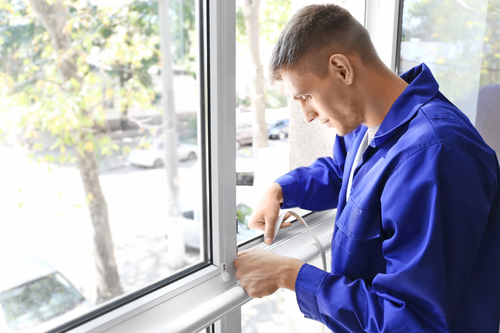We are living in an era where innovation and technology rein high. Transportation efficiencies, smart technology and tons of convenient apps are everywhere, making our lives easier. With all of the amazing inventions, homeowners are getting smart and turning towards living a greener life. It only takes just one eco-friendly adjustment to significantly impact the Earth, our communities and energy bills. Whether you choose a low-cost way or a big-ticket item to make your life greener, there is always a way to make your home more energy-efficient.

Seal Your Windows
When you walk through your home, do you feel a temperature change? Improper installation and broken seals in windows and door frames can result in major temperature changes. Whether it’s heat loss during the chilly winter months or cool air during the hot summer months, cracks and broken seals can cost you a lot of money. Older window styles and designs are made with aluminum and single panes, which are not energy efficient. If possible always choose windows that are double pane or vinyl frame. Aside from properly sealing your windows, you can also have them tinted! Having tinted windows saves tons of energy and still allows you to open the blinds and curtains to allow sunlight to flow through your home. Sunlight is an absolutely free agent for heat!
Insulate Your Home
Insulating your home is a fairly easy task that produces big results. By installing additional insulation to the floors, windows, ceilings and walls you will provide an extra coat that will fill air drafts and leaks in with cricks and cracks throughout your home. The extra insulation will preserve the warm and cool air inside your home which will minimize your energy bill by at least 25 percent. If you’re looking to add external wall insulation, call a professional. This work requires specialized knowledge and acquired skills.
Power Saving Light Fixtures
Transform your home into an energy-saving powerhouse by replacing any incandescent bulbs with fluorescent light bulbs. Fluorescent bulbs last eight-to-ten times longer! Even if you do not want to replace them entirely if you can use a combination of both. Lighting is one of the easiest ways to start saving energy. Replacing frequently used light fixtures with energy-efficient bulbs can save you between $65 and $75 each year. Energy-efficient bulbs, such as LEDs, last longer and provided the durability that is needed in throughout the summer and winter months. Halogen bulbs, compact fluorescent lamps (CFLs) and light-emitting diode (LED) bulbs offer longer lasting light and are more energy-efficient than your old incandescent bulbs.
Lower Your Thermostat
There are tons of smart thermostat options on the market to make your home more energy efficient. If you don’t want to invest in a high-tech product, adopt a new habit of lowering the temperature on your thermostat while you’re away from home. Dropping the temperature by three-to-five degrees will reduce your monthly electric bill and use less energy. Lowering the thermostat by ten-to-fifteen degrees can save 5-to-15 percent each year.
Replace Bathroom Fixtures
Bathroom fixtures which are dynamic enough to control the water flow are quite a competent and productive way to save energy. Dual flush toilets, washing machines, and shower heads can reduce general water wastage by restricting the flow to a minimal level. Installing low-flow showerheads improves your home’s water efficiency. Low-flow showerheads have a flow rate of less than 2.5 gallons per minute, while most conventional showerheads use five gallons per minute.
Limit Space Heater Use
Electric and gas space heaters keep your feet nice and toasty in cooler weather, but they aren’t the most efficient way to heat your home. Many space heaters use 1,500 watts of energy to run and are considered to be a costly way to drain your energy bill. Be sure the model of your space heater is energy-efficient; consider layering clothing or investing in blankets instead of cranking up your thermostat.
Unplug Unused Chargers
Cell phone and battery chargers that are plugged in but not in use are often referred to as energy vampires. According to research, the average charger consumes 0.26 watts of energy when not in use and 2.24 watts when connected to your phone. Alone, one charger won’t make much impact, but collectively energy vampires can be responsible for 10 percent of your energy bill. Chargers are not the only items that should be unplugged. Other items such as televisions and coffee pots can also add up to costly chargers. Even flipping the switch to turn the fan off can help save a few dollars. Every little electrical charge matters when you’re trying to save more and reduce your carbon footprint.
Re-Use and Turn Off Unnecessary Water
The average homeowner can save about $170 a year with small changes to their water usage. Be conscious of running water while brushing your teeth or shaving. Also, bathing typically uses 75 gallons of water compared to a shower that uses about 17.2 gallons on average. You also should avoid running half-loads of laundry in your washer. You can also re-use water such as rainwater to water the plants and garden.
Make Your Home More Energy-Efficient
There’s no need to rush and make all of these changes at once. Developing simple and small habits like the ones listed will help you save money in the long run, plus help create long-lasting healthy, environmentally friendly habits. Becoming energy efficient is not going to happen overnight. It requires research and time to find what works best for your home.
There are tons of ways to help make your home energy efficient. Something as simple as selecting light colors for the roof and planting trees on the west, south and eastern sides of your home can help save money. Controlling your home’s temperature and watching water usage are also big-ticket items that can save money. Whatever changes you make, remember you’re helping yourself and the environment and every small step counts!